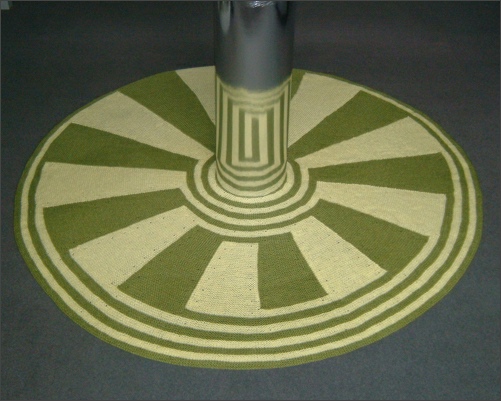




By now we were very involved in creating optical illusions in a variety of ways. As so often before, John Sharp came up with something we hadn’t thought of and suggested we look at anamorphic designs.
We had been in one of John’s workshops, many years earlier, where we had drawn shapes on distorted grids and that had probably sown the seed of an idea but it was only now, when he recommended looking at a very old free program, called Anamorph Me!, by Philip Kent, that we saw the potential for anamorphic designs.
Anamorphic art is where you have to view something from a particular place, or in some other special way, to be able to see the picture correctly. This is very often by using a cylindrical mirror. The anamorphic design is a very distorted, often almost unrecognisable, image but when it is reflected in the mirror you see the correct image.
The program was great fun to play with but we didn’t come up with anything useful for quite a long time. We didn’t want ‘arty’ pictures. We were still looking for geometrics. Then, we had a sudden realisation that we could use our own designs to generate anamorphic designs. It was just a matter of choosing what to begin with. We decided that something very simple might be best and chose the rectangular spiral of The Long and Winding Road. We were stunned at what we saw. The result was not what we expected. I don’t know what we did expect but I don’t think we could ever have imagined that it would create a circular labyrinth. It seems obvious now that if you start with something like a labyrinth this distortion will retain this basic feature and just distort it to a different shape.
The program has several variables, such as where the cylinder is placed, and how
far the design stretches round the cylinder. We wanted a compete circle because an
afghan with a gap in it isn’t much use. The design needed just a little re-
It would have been quite expensive to get a real cylindrical mirror so we experimented
with anything that came to hand. Amongst other things we tried a large coffee tin
covered in aluminium foil and a pedal bin but finally settled on a rolled-
This is a very detailed pattern. It is not difficult but the instructions must be followed systematically and carefully. Only one yarn is used at a time. Much of it is knitted in narrow pieces with no more than 40 stitches on the needle. Other parts are knitted in one piece with up to 700 stitches on the needles.
